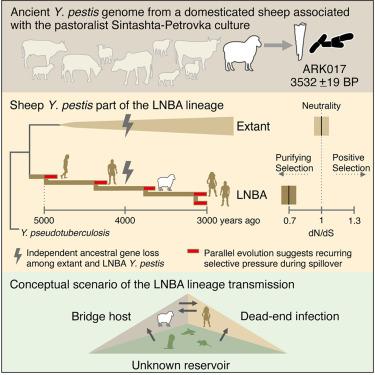青铜时代来自绵羊的鼠疫耶尔森氏菌基因组揭示了史前鼠疫谱系的宿主和进化
IF 42.5
1区 生物学
Q1 BIOCHEMISTRY & MOLECULAR BIOLOGY
引用次数: 0
摘要
大多数人类病原体是人畜共患的。许多在史前时期出现,与驯化相吻合,为人类提供了更多的机会。然而,我们缺乏将史前动物和人类感染联系起来的直接DNA证据。在这里,我们展示了一个鼠疫耶尔森氏菌基因组,该基因组来自公元前3千年前来自欧亚草原的驯化羊,属于新石器时代晚期青铜时代(LNBA)谱系,直到现在才在欧亚大陆的古代人类中发现。我们发现,这个古老的谱系与现存的谱系一样经历了祖先基因的衰变,但在不同的选择压力下进化,导致其缺乏地理分化。我们收集的证据支持一种情景,即LNBA谱系无法通过跳蚤有效传播,从一个未知的水库传播给绵羊和可能的其他驯养动物,增加了人类感染的风险。总的来说,我们的研究结果将史前牲畜与人类传染病联系起来,并展示了将古微生物学带入动物考古学记录的力量。本文章由计算机程序翻译,如有差异,请以英文原文为准。

Bronze Age Yersinia pestis genome from sheep sheds light on hosts and evolution of a prehistoric plague lineage
Most human pathogens are of zoonotic origin. Many emerged during prehistory, coinciding with domestication providing more opportunities for spillover into human populations. However, we lack direct DNA evidence linking animal and human infections during prehistory. Here, we present a Yersinia pestis genome recovered from a 3rd-millennium BCE domesticated sheep from the Eurasian Steppe belonging to the Late Neolithic Bronze Age (LNBA) lineage, until now exclusively identified in ancient humans across Eurasia. We show that this ancient lineage underwent ancestral gene decay paralleling extant lineages, but evolved under distinct selective pressures, contributing to its lack of geographic differentiation. We collect evidence supporting a scenario where the LNBA lineage, unable to efficiently transmit via fleas, spread from an unidentified reservoir to sheep and likely other domesticates, elevating human infection risk. Collectively, our results connect prehistoric livestock with infectious disease in humans and showcase the power of moving paleomicrobiology into the zooarchaeological record.
求助全文
通过发布文献求助,成功后即可免费获取论文全文。
去求助
来源期刊

Cell
生物-生化与分子生物学
CiteScore
110.00
自引率
0.80%
发文量
396
审稿时长
2 months
期刊介绍:
Cells is an international, peer-reviewed, open access journal that focuses on cell biology, molecular biology, and biophysics. It is affiliated with several societies, including the Spanish Society for Biochemistry and Molecular Biology (SEBBM), Nordic Autophagy Society (NAS), Spanish Society of Hematology and Hemotherapy (SEHH), and Society for Regenerative Medicine (Russian Federation) (RPO).
The journal publishes research findings of significant importance in various areas of experimental biology, such as cell biology, molecular biology, neuroscience, immunology, virology, microbiology, cancer, human genetics, systems biology, signaling, and disease mechanisms and therapeutics. The primary criterion for considering papers is whether the results contribute to significant conceptual advances or raise thought-provoking questions and hypotheses related to interesting and important biological inquiries.
In addition to primary research articles presented in four formats, Cells also features review and opinion articles in its "leading edge" section, discussing recent research advancements and topics of interest to its wide readership.
 求助内容:
求助内容: 应助结果提醒方式:
应助结果提醒方式:


